TOSHIBA PDR-M700, PDR-M500 User Manual
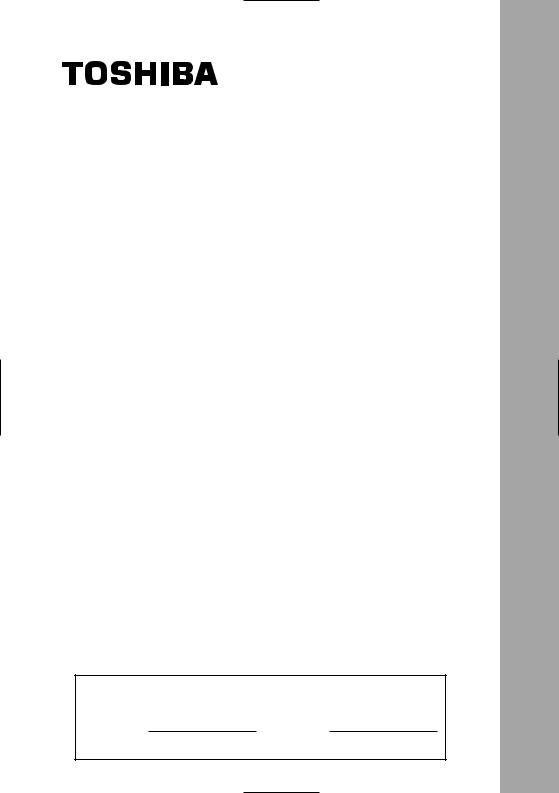
INSTRUCTION MANUAL
To ensure that you use the Toshiba PDR-M700/PDR-M500 Digital Still Camera safely and correctly, read this Instruction Manual carefully before you start using the camera. Once you have finished reading this Instruction Manual, keep it handy at all times.
DIGITAL STILL CAMERA
PDR-M700 PDR-M500
In the space provided below, please record the model and Serial No. of your camera.
Model No. |
Serial No. |
Please retain this information for future reference.
ENGLISH



 Attention
Attention














For customers in the U.S.A.
DIGITAL STILL CAMERA PDR-M700 |
|
DIGITAL STILL CAMERA PDR-M500 |
Tested To Comply |
|
Tested To Comply |
With FCC Standards |
|
With FCC Standards |
FOR HOME OR OFFICE USE |
|
FOR HOME OR OFFICE USE |
|
|
|
FCC Statement
This device complies with Part 15 of the FCC Rules. Operation is subject to the following two conditions:
(1)This device may not cause harmful interference, and
(2)This device must accept any interference received, including interference that may cause undesired operation.
NOTE
This equipment has been tested and found to comply with the limits for a Class B digital device, pursuant to Part 15 of the FCC Rules. These limits are designed to provide reasonable protection against harmful interference in a residential installation.
This equipment generates, uses and can radiate radio frequency energy and, if not installed and used in accordance with the instructions, may cause harmful interference to radio communications. However, there is no guarantee that interference will not occur in a particular installation. If this equipment does cause harmful interference to radio or television reception, which can be determined by turning the equipment OFF and ON, the user is encouraged to try to correct the interference by one or more of the following measures:
•Change the direction of the radio or TV antenna.
Move the equipment or the radio or TV. For example, if the equipment is to the right of the
TV, move it to the left of the TV.
Or, move the equipment farther away from the radio or TV.
•Plug the equipment into a different outlet. Don’t plug your radio or TV into the same circuit as your equipment.
•Ensure that all expansion slots (on the back or side of the equipment) are covered.
Also, ensure that all metal retaining brackets are tightly attached to the equipment.
•If these suggestions don’t help, consult your equipment dealer or experienced radio/TV technician for help.
CAUTION
If you modify the camera in any way, without getting approval from Toshiba Corporation, your camera may violate FCC regulations. Violation of FCC regulations may cause the FCC to void your right to use the modified camera.
TOSHIBA AMERICA INFORMATION SYSTEMS, INC.
Imaging Systems Division
9740 Irvine Boulevard,
Irvine, California 92618-1697
Phone Number: (800)288-1354
For customers in Canada
CAUTION
This Class B digital apparatus complies with Canadian ICES-003.
2
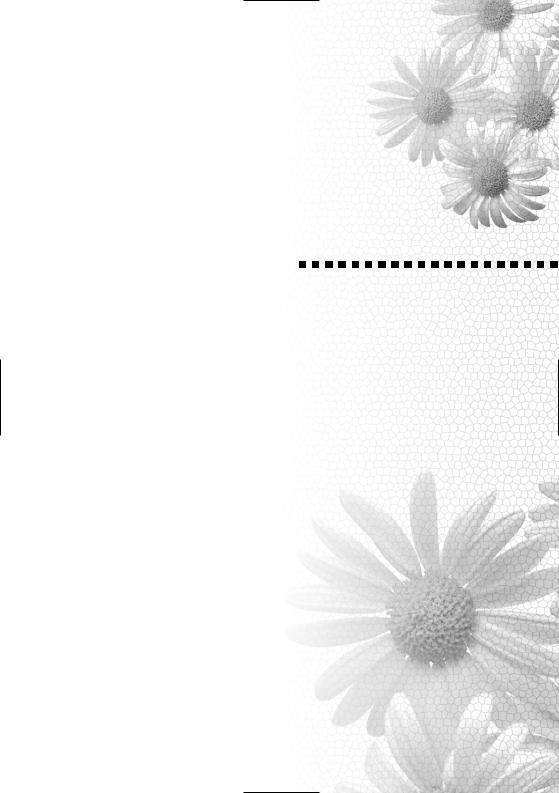
Preface
Before Using Your Camera
Accessories
Safety Precautions
Contents
Handling Your Camera
About Batteries
Handling the AC Adapter Correctly About the SD Memory Card (provided)
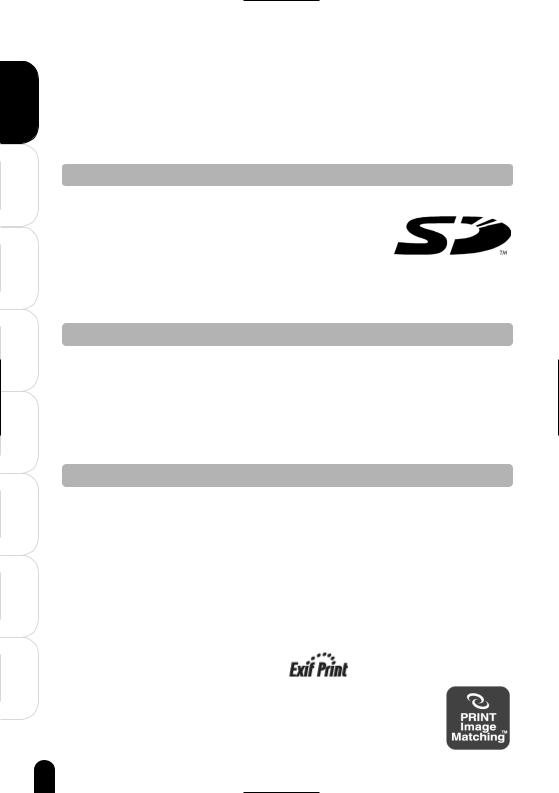
 Before Using Your Camera
Before Using Your Camera
Preface
Thank you for buying this TOSHIBA Digital Still Camera.
To ensure correct use of your Digital Still Camera, be sure to thoroughly read this Instruction Manual before you start using the camera. Always keep this Instruction Manual close by after you have finished reading it.
The design, specifications, software and content of this Instruction Manual are subject to change without notice in the interest of product improvement.
Getting |
Ready |
Taking |
Photographs |
PlayingBack |
PhotographedImages |
Deleting |
PhotographedImages |
Trademark Information
•Microsoft, Windows, DirectX and Windows Media are registered trademarks in the U.S. and other countries by the U.S. Microsoft Corporation. Windows is an abbreviated term referring to the Microsoft Windows Operating System.
•Macintosh and Mac OS is a registered trademark of Apple
Computer, Inc.
•ACDSee is a trademark of ACD Systems Co.
•SD logo is a trademark.
•MultiMediaCard is a trademark of Infineon Technologies AG in Germany.
•Other company or product names are trademarks or registered trademarks of the respective companies.
Copyright Notice
Images taken with digital still cameras are for personal enjoyment only and must not be used, indicated, distributed, or exhibited, etc. otherwise without the permission of the copyright holder as per copyright laws.
Note that photographing some performances, exhibitions, etc., is restricted even when photographs are taken for personal enjoyment. In addition, the transfer of memory cards (SD cards, etc.) containing copyrighted images and files is limited to purposes within the range permitted by copyright laws.
Connectingto |
thePC |
OtherUseful |
Information |
Additional |
Information |
About the Used Terms
•Windows 98
Windows 98 refers to Microsoft® Windows® 98 Operating System.
•Windows 2000
Windows 2000 refers to Microsoft® Windows® 2000 Operating System.
•Windows Me
Windows Me refers to Microsoft® Windows® Me Operating System.
•Windows XP
Windows XP refers to Microsoft® Windows® XP Operating System.
“WARNING: Handling the cord on this product or cords associated with accessories sold with this product, will expose you to lead, a chemical known to the State of California to cause [cancer, and] birth defects or other reproductive harm. Wash hands after handling.”
This digital still camera supports Exif Print.
This digital still camera supports PRINT Image Matching II.
It is possible to faithfully reflect the actual conditions of when the picture was taken and the photographer’s intentions with image processing software or a printer that supports PRINT Image Matching II.
4

 Accessories
Accessories
Make sure that you have all of the items below. If any item is missing, damaged or mismatched, promptly contact your dealer.
Alkaline batteries (4) (size AA) |
SD Memory card |
Lens cap |
Shoulder strap |
Camera case |
Remote controller |
||
|
|
W |
|
|
|
REV |
|
|
|
F |
T |
|
STA |
|
WD |
|
RT/ST |
|
|
|
|
|
|
|
|
OP |
|
AV cable |
Adapter ring |
||
Software CD-ROM (1) |
USB cable |
Software application |
|
USB driver (for Windows 98) |
|
|
B |
• Instruction Manual (this manual) |
Sold separately |
|
• AC adapter (PDR-AC20) |
|
Preface |
Ready |
Getting |
Photographs |
Taking |
PhotographedImages |
PlayingBack |
PhotographedImages |
Deleting |
thePC |
Connecting |
|
to |
Information |
OtherUseful |
Information |
Additional |
5

 Safety Precautions
Safety Precautions
|
● Read these safety precautions carefully before using this product. |
|
Preface |
● These precautions provide valuable safety instructions that you must observe. |
|
● The indications used for the precautions have the following meanings: |
||
|
Getting |
Ready |
Taking |
Photographs |
PlayingBack |
PhotographedImages |
Deleting |
PhotographedImages |
Connectingto |
thePC |
OtherUseful |
Information |
Additional |
Information |
Indication definitions
Indication |
Meaning |
|
DANGER |
Indicates the existence of an imminent hazard such that death or |
|
serious bodily injury (*1) may result from improper use. |
||
|
|
|
|
|
Indicates the existence of a hazard such that death or serious bodily |
|
|
|
|
|
injury (*1) may result from improper use. |
|
|
|
|
|
|
CAUTION |
Indicates the existence of a hazard such that bodily injury (*2) or |
|
property damage (*3) may result from improper use. |
||
|
|
|
|
|
*1: “Serious bodily injury” means loss of eyesight, injuries, burns (high |
|
|
and low temperature), electric shock, fracture, poisoning, etc. which |
|
|
leaves a sequela and requires hospitalization or prolonged |
|
|
treatment. |
|
|
*2: “Bodily injury” means injuries, burns, electric shock, etc. which does |
|
|
not require hospitalization or prolonged treatment. |
|
|
*3: “Property damage” means extended harm to home, household |
|
|
effects, domesticated animals, pets, etc. |
Graphic symbol definitions
Graphic symbol |
Meaning |
Indicates a prohibited action that must not be carried out. The actual prohibited action is indicated in the symbol or nearby graphically, or described in text.
Indicates a necessary action that must be carried out. The actual necessary action is indicated in the symbol or nearby graphically, or described in text.
Exemption Clauses
•Toshiba Corporation bears no responsibility in the case of damages arising from natural disasters such as earthquakes, fire, lightning, acts by third parties, other accidents, either intentional or negligent misuse by the user, or use under other abnormal operating conditions.
•Toshiba Corporation bears no responsibility for incidental damages (lost profit, suspension of business activities, corruption or loss of the memory contents, etc) arising from the use of or the inability to use this product.
•Toshiba Corporation accepts no liability whatsoever for any damage arising from not having followed the descriptions in the Instruction Manual.
•Toshiba Corporation accepts no liability whatsoever for any damages arising from malfunctions resulting from combination with equipment or software that is not related to Toshiba Corporation.
•Toshiba Corporation accepts no liability whatsoever for any damages arising from repair or modifications made by the user or an unauthorized third party.
•Toshiba’s liability for the product shall not exceed the purchase price of the product under any circumstances within the limits of the law.
6

When using the product
WARNING
Should you ever notice a strange odor, smoke, or excessive heat coming from the camera, and remove the batteries and AC adapter.
Continued use in this state might cause fire, electric shock, or burns. Take care not to burn yourself if the battery gets hot. For details on repair, consult the store of purchase.
If foreign objects or water have entered the camera, turn the power OFF and remove the batteries and AC adapter.
Continued use in this state might cause fire or electric shock. Consult the store of purchase.
If the camera has fallen or its case has been damaged, turn the power OFF and remove the batteries and AC adapter.
Continued use in this state might cause fire or electric shock. Consult the store of purchase.
Do not allow metallic objects or flammable foreign matter inside the camera.
This might cause fire or electric shock. Do not insert or drop foreign objects in the batteries/card slot, terminals, other holes or openings.
Do not use the camera in areas near water.
This might cause fire or electric shock. Take special care during rain, snow, on the beach, or near the shore.
Do not use the camera in the bath or shower.
This might cause fire or electric shock.
Do not place the camera on inclined or unstable surfaces.
This might cause the camera to fall or tilt over, causing injury or malfunction.
Do not disassemble, change, or repair the camera.
This might cause fire or electric shock. For repair or internal inspection, ask the store of purchase.
Do not touch power cables and TV cables during a thunderstorm.
This might cause electric shock.
Do not use the camera while walking, driving, or riding a motorcycle.
This might cause you to fall over or result in a traffic accident.
If you want to use the camera on an airplane, consult the airline company and follow their instructions.
Use of the camera is sometimes restricted because of potential radio interference.
Do not use the camera in humid, steamy, smoky, or dusty places.
This might cause fire or electric shock.
Do not leave the camera in places where the temperature may rise significantly, such as inside a car.
This might adversely affect the case or the internal parts, resulting in fire.
Do not play the supplied CD-ROM with a music CD player or a similar device.
This might damage the headphone or speaker, and/or may damage your ears.
Do not drop or subject the camera to strong impact.
This might cause fire, electric shock, or malfunction.
Before moving the camera, disconnect the cables.
Neglecting this might damage the cables, resulting in fire or electric shock.
|
Preface |
Ready |
Getting |
Photographs |
Taking |
PhotographedImages |
PlayingBack |
PhotographedImages |
Deleting |
thePC |
Connecting |
|
to |
Information |
OtherUseful |
Information |
Additional |
7
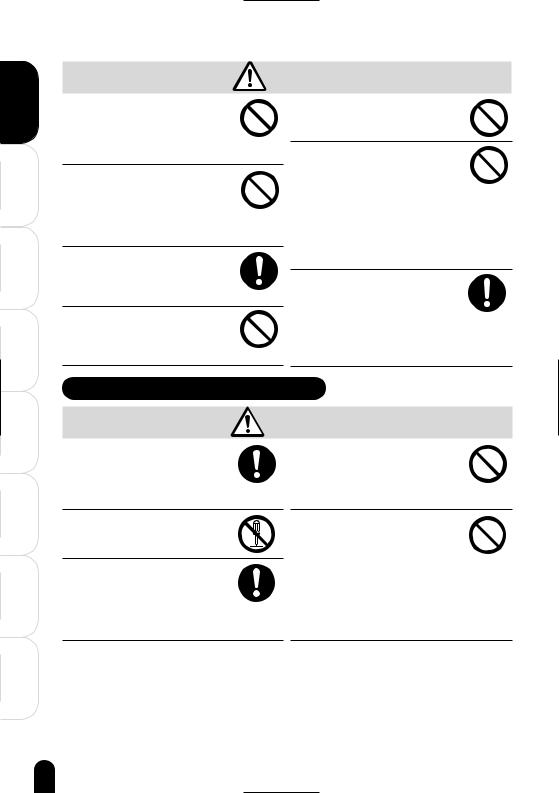
 Safety Precautions (Continued)
Safety Precautions (Continued)
Preface |
|
Getting |
Ready |
Taking |
Photographs |
PlayingBack |
PhotographedImages |
Do not wrap the camera or place it cloth or blankets.
This might cause heat to build up and deform the case, resulting in fire. Use the camera in a well-ventilated place.
Do not swing the camera while walking.
If you hold the strap and swing the camera, the camera might come into contact to other people or any object, resulting in injury or malfunction.
Before cleaning the camera, remove the batteries and AC adapter.
Neglecting this might cause electric shock.
Do not look at the sun through the viewfinder.
This might cause damage to the eyesight.
(Continued)
Do not fire the flash near the eyes.
This might cause temporary damage to the eyesight.
Do not subject the LCD monitor to impact.
This might damage the glass on the screen or cause the internal fluid to leak. If the internal fluid enters your eyes or comes into contact with your body or clothes, rinse with fresh water. If the internal fluid has entered your eyes, consult a physician to receive treatment
For the internal cleaning of the camera, consult the store of purchase every two years.
If dust accumulates inside the camera, this might result in fire or malfunction. Consult the store of purchase regarding the cleaning costs.
About the AC adapter (sold separately)
Deleting |
PhotographedImages |
Connectingto |
thePC |
OtherUseful |
Information |
Additional |
Information |
Use the AC adapter only with the indicated power supply voltage.
Use with any other power supply voltage might cause fire or electric shock.
Do not disassemble, modify, or repair the AC adapter.
This might cause fire or electric shock.
If dirt or dust has adhered to the plug on the AC adapter cable or the plug joints, remove the plug from the power source and clean it.
The insulation decrease of the plug might result in fire.
WARNING
Do not place blankets over the AC adapter connected with the power source or place the adapter near a heater or on an electric (warm) carpet.
This might cause fire or malfunction.
Do not damage, modify (e.g., to extend), or heat the AC adapter cable.
Do not pull the AC adapter cable, place something heavy on it, or pinch it.
Do not bend, twist, or bundle the AC adapter cable with an excessive force.
These might cause fire or electric shock.
8

Do not connect or disconnect the AC adapter plug with a wet hand.
This might cause electric shock.
Do not remove the AC adapter plug from a wall outlet by pulling the actual cable.
This might damage the cable or plug, resulting in fire or electric shock. Make sure to hold the plug when removing it.
Use only the supplied AC adapter and power cable.
Use of an AC adapter other than specified might cause fire or malfunction.
If you plan not to use the camera for a long period of time, remove the AC adapter plug from a wall outlet.
Malfunction on the camera, if it happens, might result in fire.
Do not use the AC adapter with another model or device.
This might cause fire or malfunction.
Firmly insert the AC adapter plug into a wall outlet.
Neglecting this might cause fire or electric shock.
About battery
DANGER
Do not heat, disassemble or throw the batteries into fire or water.
This might cause the batteries to rupture, ignite or heat up, resulting in fire or serious injury.
Do not hit the batteries with a hammer, or step, drop, or subject the batteries to strong impact.
This might cause the batteries to rupture, ignite or heat up, resulting in fire or serious injury.
Use the batteries only for specified applications.
Use of the batteries for other applications might cause them to rupture, ignite or heat up, resulting in fire or serious injury.
Use only the specified batteries.
Use of a battery other than specified might cause fire or malfunction.
Do not leave batteries within the reach of small children.
Swallowing batteries might cause poisoning. If you accidentally swallow the battery, contact a doctor immediately.
WARNING
If fluid leaks from the batteries and comes into contact your eyes, immediately wash your eyes with clean, running water, and ask a physician for treatment.
Leaving your eyes in this condition might cause eye damage.
Do not connect the battery electrodes (+ or - terminals) with wire or other metallic objects. Also, do not carry or store batteries together with metallic necklaces, or pins or other metallic objects.
Short-circuiting of the electrodes might cause the batteries to heat up, rupture or ignite.
|
Preface |
Ready |
Getting |
Photographs |
Taking |
PhotographedImages |
PlayingBack |
PhotographedImages |
Deleting |
thePC |
Connecting |
|
to |
Information |
OtherUseful |
Information |
Additional |
9

 Safety Precautions (Continued)
Safety Precautions (Continued)
Preface |
|
Getting |
Ready |
Taking |
Photographs |
PlayingBack |
PhotographedImages |
Deleting |
PhotographedImages |
Connectingto |
thePC |
OtherUseful |
Information |
Additional |
Information |
Do not charge the batteries supplied with the Digital Still Camera.
This might cause then to leak fluid or rupture, resulting in burns or injury.
Do not insert used up batteries or batteries that have exceeded their “recommended limit of use” indicated on the batteries.
This might cause them to leak fluid or rupture, resulting in burns, injury or malfunction.
When replacing the batteries, replace four completely fresh batteries.
Otherwis, the batteries may rupture, ignite or heat up, resulting in fire, burns, or injury, or physical damage to the camera. “Fresh batteries” refers to two batteries that have been fully charged at the same time recently when replacing with Nickel-Hydrogen batteries.
Do not use fresh batteries together with old batteries or different types of batteries.
This might cause the batteries to rupture, ignite or heat up, resulting in fire, burns, or injury, or physical damage to the camera.
Do not remove the batteries immediately after the camera has been used for a long time.
The batteries become hot during use. Touching a hot battery might cause burns.
Remove the batteries when the camera is not to be used for a long time.
This might cause fire.
Insert the batteries carefully making sure that their polarities (marked by + and -) are facing the correct way.
Inserting the batteries with their polarities facing the wrong way, this might cause fire or injury, or damage to the surrounding area due to the battery rupturing or leaking.
Before storing or disposing of used batteries, attach electrode covers, or attach insulating tape to both the plus (+) and (-) electrodes.
Storing or disposing of batteries as they are might cause the batteries to leak fluid, heat up or rupture, resulting in burns or injury.
About the shoulder strap
Keep the shoulder strap away from infants and young children.
If the strap is mistakenly wrapped around the neck, suffocation and injury may result.
WARNING
When you are using the shoulder strap, be careful not to get it caught in the doors of trains or cars etc.
Suffocation and injury may result.
10


 Contents
Contents















Attention ....................................................... |
2 |
Displaying Images Enlarged ...................... |
67 |
||
|
|
Playing Back Movies .................................. |
68 |
||
Preface |
|
Changing the Playback Menu Settings ...... |
70 |
||
Before Using Your Camera |
4 |
• PROTECT .................................................. |
71 |
||
• DPOF |
71 |
||||
Accessories |
5 |
||||
• SLIDESHOW |
71 |
||||
Safety Precautions |
6 |
||||
• |
RESIZE |
72 |
|||
Contents |
11 |
||||
• |
DISPLAY SETTINGS |
72 |
|||
Handling Your Camera |
12 |
||||
• LCD BRIGHTNESS |
72 |
||||
About Batteries |
13 |
||||
DPOF Settings |
73 |
||||
Handling the AC Adapter Correctly |
14 |
||||
Protecting Images |
76 |
||||
About the SD Memory Card (provided) |
15 |
||||
Display Settings |
78 |
||||
|
|
||||
|
Getting Ready |
|
Names of the Parts .................................... |
18 |
|
Installing and Removing the Batteries ........ |
20 |
|
Using the AC Power Adapter ...................... |
22 |
|
Inserting and Removing the SD Card ........ |
23 |
|
Turning the Power ON/OFF ....................... |
24 |
|
Setting the Date and Time .......................... |
25 |
|
About the Remote Controller ...................... |
26 |
|
|
Taking Photographs |
|
Photography (Auto Photography) ............... |
28 |
|
Selecting the Scene Mode ......................... |
30 |
|
Selecting the Focus .................................... |
32 |
|
Selecting the Flash Mode ........................... |
34 |
|
Using the Self-timer .................................... |
36 |
|
Zoom Photography ..................................... |
37 |
|
Photography (Manual Photography) .......... |
38 |
|
Selecting the Exposure (EXP) .................... |
40 |
|
Selecting the White Balance (WB) ............. |
45 |
|
Selecting the Photometry Mode (AE) ......... |
48 |
|
Selecting the Capture Mode (S/C) ............. |
49 |
|
Exposure Compensation ............................ |
52 |
|
Taking Movies ............................................ |
53 |
|
Taking Photographs with the Remote |
|
|
Controller .................................................... |
54 |
|
Changing the Photography |
|
|
Menu Settings ............................................ |
55 |
|
• |
ISO ............................................................. |
56 |
• |
DIGITAL ZOOM .......................................... |
56 |
• |
QUALITY SETTING .................................... |
57 |
• CREATE FOLDER ...................................... |
58 |
|
• |
PICTURE .................................................... |
59 |
• |
DISPLAY SETTINGS .................................. |
60 |
• LCD BRIGHTNESS .................................... |
61 |
|
About the Adapter Ring .............................. |
62 |
|
Playing Back Photographed Images |
||
Playing Back Photographed Images .......... |
64 |
|
Displaying Image Information ..................... |
65 |
|
Displaying a List of Images |
|
|
(Thumbnail Display) ................................... |
66 |
|
Deleting Photographed Images
Erasing Images .......................................... |
82 |
Formatting the SD Card ............................. |
84 |
Connecting to the PC |
|
About Your Software .................................. |
86 |
Connecting to the PC ................................. |
87 |
Connecting to a Windows PC .................... |
88 |
Connecting to a Macintosh ......................... |
92 |
Changing the Image Size ........................... |
95 |
Copying Computer Images to the |
|
Camera ...................................................... |
96 |
Disconnecting the Camera from the PC ..... |
97 |
Other Useful Information |
|
Basic Settings .......................................... |
100 |
• SOUND .................................................... |
101 |
• AUTO POWER OFF ................................. |
102 |
• CUSTOMIZE ............................................ |
102 |
• LANGUAGE ............................................. |
102 |
• VIDEO OUT .............................................. |
103 |
• TIME&DATE ............................................. |
103 |
• SYSTEM ................................................... |
104 |
Customize ................................................ |
105 |
• LED COLOR ............................................. |
105 |
• STARTING DISPLAY ................................ |
106 |
About LED ................................................ |
108 |
Taking and Playing Back |
|
Photographs on a TV ............................... |
109 |
Additional Information |
|
Specifications ........................................... |
112 |
Warning Messages ................................... |
113 |
Troubleshooting ........................................ |
114 |
Q&A .......................................................... |
116 |
Glossary ................................................... |
117 |
Global Contacts ........................................ |
118 |
Index ........................................................ |
119 |
11
|
Preface |
Ready |
Getting |
Photographs |
Taking |
PhotographedImages |
PlayingBack |
PhotographedImages |
Deleting |
thePC |
Connecting |
|
to |
Information |
OtherUseful |
Information |
Additional |



 Handling Your Camera
Handling Your Camera








Preface |
|
Getting |
Ready |
Taking |
Photographs |
PlayingBack |
PhotographedImages |
Before using the camera, carefully read and strictly observe the Safety Precautions ( page 6) and the notes described below:
page 6) and the notes described below:
Avoid Using or Storing the Camera in the Following Places
•Places subject to humidity, dust, and dirt
•Places subject to direct sunlight
•Places subject to high or low temperature
•Places filled with highly flammable gas
•Places near gasoline, benzene, or paint thinner
•Places subject to strong vibration
•Places subject to smoke or steam
•Places subject to strong magnetic fields (near electric motors, transformers, magnets, etc.)
•Places contacting chemicals (such as pesticides), rubber or vinyl products for a long period of time
Prevent the Digital Still Camera from Coming into Contact with Sand
If the camera comes into contact with sand, not only will the camera become damaged, it will also no longer be reparable.
Take special care when using the Digital Still Camera at the seaside, sandy areas or places where sand dust is likely to occur.
Pay Attention to Condensation
Deleting |
PhotographedImages |
Connectingto |
thePC |
OtherUseful |
Information |
Additional |
Information |
Due to a sudden change in temperature, such as when you move the camera from a cold location to a warm one, water droplets (condensation) may form on the inside of the camera or on the lens.
When this occurs, turn the power OFF, and wait an hour before using the camera. If condensation forms on the SD Memory card, remove the SD Memory card, wipe off any condensation and wait a short time before using it again.
When Cleaning the Camera
•To prevent the lens and the surface of the LCD monitor from being scratched, blow off any dust from them with a blower brush and lightly wipe with a soft dry cloth.
•Clean the body of the camera with a soft dry cloth. Do not use volatile liquids such as paint thinner, benzene, or insecticide because these may react with the camera body and cause deformation or remove the coating.
12


 About Batteries
About Batteries 











Recommended Batteries
We recommend using the following batteries to fully demonstrate this camera's functions:
•AA Nickel Metal Hydride rechargeable batteries
This camera is not provided with a charging function. Use a charger (commercially available) to charge Nickel Metal Hydride batteries.
•AA Lithium batteries (non-rechargeable)
•CR-V3 Lithium Battery Pack (non-rechargeable)
About Non-recommended Batteries
•AA Manganese type batteries cannot be used.
•AA Alkaline batteries can be used. You can take several shots, except that low temperature and cold weather.
Please use a recommendation batteries at low temperature. Pay attention to this when purchasing batteries.
•We do not recommend AA NiCad batteries because of their adverse influence on the environment.
About Battery Life
Battery life varies greatly according to battery manufacturer and storage length, camera and battery temperature, and photographic conditions (for example, whether or not the flash is used). Moreover, if the polarities of the battery (+ or -) and the terminal of the camera that come in contact with the electrodes are contaminated, electricity will not flow properly and the camera will decide that the batteries are exhausted. When removing and loading the batteries, be careful not to touch these parts. If the parts are contaminated, clean with a dry cloth.
Battery life is as follows when the alkaline batteries (provided) are used:
Photography mode
Conditions |
: +77°F (+25°C), Flash use rate 100% |
Photography interval |
: 1 frame every 30 seconds |
Number of photographs : Approx. 180 frames |
|
Playback mode |
|
Conditions |
: +77°F (+25°C), Slideshow executed |
Playback time |
: Approx. 180 minutes |
*The number of photographs and playback time mentioned here are only reference values, they are not guaranteed.
Skillful Use of Batteries
The camera consumes a small amount of electricity even when the power is turned OFF. We recommend removing the batteries when the camera is not to be used for a long period of time. If the camera is left without battery about a week, the date, time and other settings may be reset to the factory defaults. If this happens, set the correct date and time again before using the camera. When using the camera in cold areas, keep the camera and batteries warm by holding them on the inside of your clothing.
In cold temperatures, battery performance drops, and the number of photographs that can be shot decreases. Battery performance, however, is restored when the batteries are returned to a temperature of about 25°C.
|
Preface |
Ready |
Getting |
Photographs |
Taking |
PhotographedImages |
PlayingBack |
PhotographedImages |
Deleting |
thePC |
Connecting |
|
to |
Information |
OtherUseful |
Information |
Additional |
13
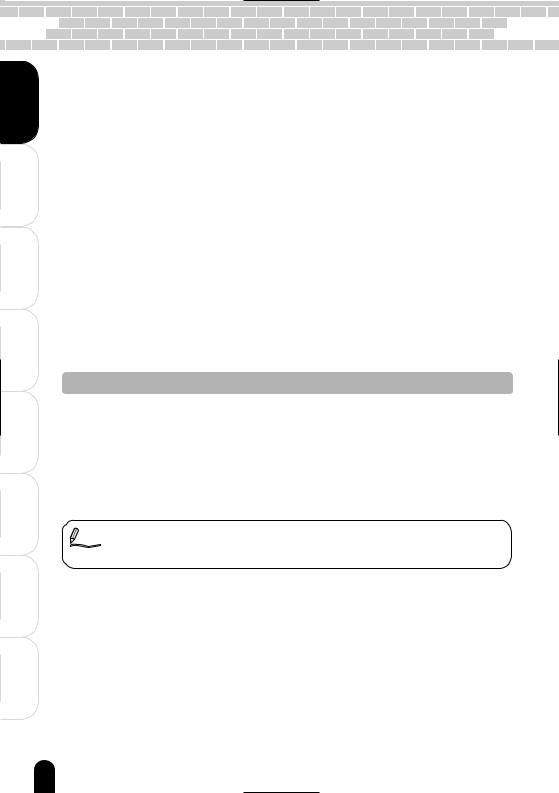


 Handling the AC Adapter Correctly
Handling the AC Adapter Correctly 


Preface |
|
Getting |
Ready |
Taking |
Photographs |
PlayingBack |
PhotographedImages |
Deleting |
PhotographedImages |
Connectingto |
thePC |
OtherUseful |
Information |
Additional |
Information |
Be sure to use only the specified AC adapter (PDR AC20) (sold separately). Using a different AC adapter might cause the camera to malfunction.
Before using the AC adapter, carefully read and strictly observe the Safety Precautions ( page 6) and the notes described below:
page 6) and the notes described below:
•Do not allow the connectors on the AC adapter to contact any other metal object because this might cause a short circuit.
•To connect the AC adapter, fully insert the plug on the AC adapter into the DC IN 5V terminal on the camera.
•When removing the AC adapter cable, turn the power OFF, then disconnect the cable while holding its plug. Do not disconnect the cable by pulling the actual cable.
•Do not drop the AC adapter or subject it to strong impacts.
•Do not use the AC adapter in very hot and humid places.
•Do not insert the plug on the AC adapter while the batteries is being used. Turn the power OFF first.
•The AC adapter is for indoor use only.
•The AC adapter may sometimes become warm during use. This does not designate malfunction.
•Buzzing noises may come form inside the camera. This does not designate malfunction.
•Do not use the AC adapter near a radio because it could interfere with the radio.
•If you remove the batteries or AC adapter while the camera is in operation, the date may be lost from the memory. If this happens, reset the date.
Specifications
AC adapter (PDR-AC20)
Input |
: |
100 V to 240 V AC, 50/60 Hz |
Rated output |
: |
5 V DC, 3 A |
Operating temperature : |
32°F (0°C) to +104°F (+40°C) |
|
Storage temperature |
: |
–4°F (–20°C) to +149°F (+65°C) |
Dimensions |
: |
40.0 mm × 30.5 mm × 94.2 mm (W × H × D) |
Weight |
: |
Approx. 150 g |
Accessory |
: |
Instruction Manual, AC cable |
Memo |
• Use the power supply indicated on the supplied AC cable. When using power supply |
|
other than the displayed voltage in other countries/region, please purchase the AC |
|
cable that applies to the standard of the country/region. |
14


 About the SD Memory Card (provided)
About the SD Memory Card (provided) 



In this Instruction Manual, the SD memory card is called an SD card. Read and observe the following when handling the supplied SD card.
Cautions
•The SD card includes a non-volatile semiconductor memory (NAND Flash EEP-ROM).
Under normal use data saved in the SD card is not damaged or lost. If used improperly, however, the data may be damaged or lost. Please be aware that Toshiba Corporation will accept no responsibility whatsoever for damaged or lost data, regardless of the type or cause of the problem or damage.
•The SD card uses part of the memory as its system area. The actually usable memory capacity is therefore lower than the indicated capacity.
•The supplied SD card has been already formatted for image storage. Always use this camera when reformatting the card to erase images or folders. Formatting the SD card on other devices (PC, etc.) may result in problems such as inability to read or write data.
•We strongly recommend that you make backups of important data.
•When the SD card comes to the end of its life, it does not allow image data to be written or deleted. If this happens, purchase a new SD card.
•This camera conforms to the SD standard Ver. 1.01.
|
Preface |
Ready |
Getting |
Photographs |
Taking |
Write Protection
To prevent valuable data from being erased accidentally, switch the write protection tab at the side of the SD card to “LOCK.” To save, edit, or erase data in the card, cancel the write protection state.
LOCK |
LOCK |
Write protection |
Write protection |
tab |
state |
PhotographedImages |
PlayingBack |
PhotographedImages |
Deleting |
Specifications
Memory type |
: |
NAND Flash memory |
Operating temperature |
: |
+32°F (0°C) to +131°F (+55°C) |
Storage temperature |
: |
–4°F (–20°C) to +149°F (+65°C) |
Operating/Storage humidity : |
30% to 80% (no condensation) |
|
Dimensions |
: |
24.0 mm × 32.0 mm × 2.1 mm (W × H × D) |
Weight |
: |
Approx. 2g |
Important • They are checked up with SD card published by April 2003.
thePC |
Connecting |
|
to |
Information |
OtherUseful |
Information |
Additional |
15


Getting Ready
Names of the Parts
Installing and Removing the Batteries
Using the AC Power Adapter
Inserting and Removing the SD Card
Turning the Power ON/OFF
Setting the Date and Time
About the Remote Controller



 Names of the Parts
Names of the Parts









Preface |
|
Getting |
Ready |
Taking |
Photographs |
POWER switch ( page 24)
page 24)
Mode dial
Shutter button ( page 28)
page 28) 
Remote control sensor ( page 26)
page 26)
Flash adjustment sensor
Front LED (  page 105, 108)
page 105, 108)
Lens
Flash ( page 34)
page 34)
Flash open button ( page 34)
page 34)
Speaker
Microphone
Terminal cover
MIC (external microphone IN) terminal (Compatible mike: ø3.5 mini-plug, monophonic, output impedance 1.8 kΩ)
DIGITAL terminal ( page 88, 92)
page 88, 92)
AV terminal ( page 109)
DC IN 5V terminal ( page 22)
page 22)
PlayingBack |
PhotographedImages |
Deleting |
PhotographedImages |
Connectingto |
thePC |
OtherUseful |
Information |
Additional |
Information |
 Mode dial
Mode dial
Auto photography mode |
Manual photography mode |
page 28 |
page 38 |
This mode is for taking |
This mode is for manually |
photographs automatically |
setting white balance, |
depending on the |
exposure, f stop, shutter |
photographic conditions. |
speed, and AE (Automatic |
Photographs can be taken |
Exposure) position. |
easily as the camera |
|
automatically controls the |
|
exposure (combination of |
|
shutter speed and aperture) |
|
and other settings. |
Movie mode |
|
page 53 |
Playback mode page 64 |
This mode is for taking |
movies. |
|
This mode is for playing |
|
back images, and RESIZE, |
|
PROTECT and DPOF |
SET-UP mode page 100 |
settings. |
This mode is for setting the |
|
camera’s basic settings |
PC mode page 88 |
(SOUND/AUTO POWER |
OFF/CUSTOMIZE/LANGUAGE/ |
|
This mode is for loading |
VIDEO OUT/TIME & |
images to the PC. |
DATE/SYSTEM). |
18
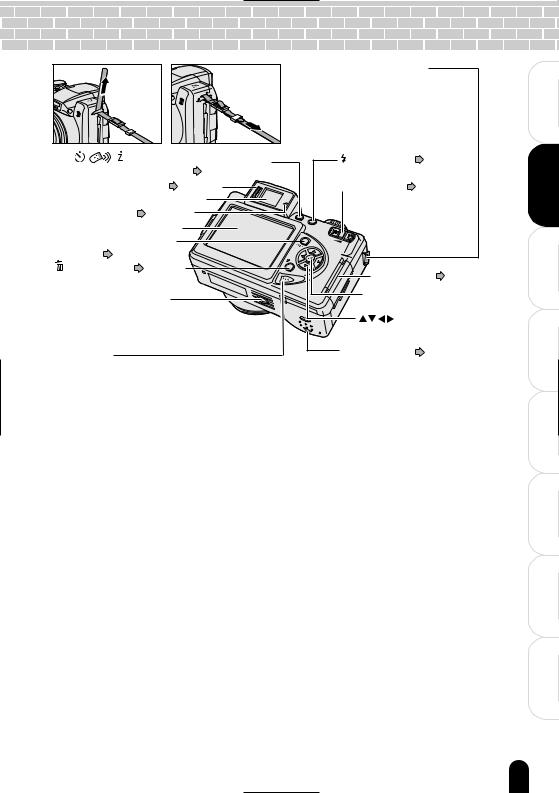
|
|
Shoulder strap attachment |
|
|
|
As shown in the figure, pass the end of |
|
|
|
the shoulder strap through the strap |
|
|
|
attachment and fasten it to the fixture. |
|
|
|
Attach the other end of the strap in the |
|
|
|
same way. |
|
/ self-timer & remote controller/ |
flash button ( |
page 34) |
|
INFO. button ( page 36, 54, 65) |
|
|
|
Diopter adjustment dial ( page 28) |
Tele/Wide button ( |
page 37, 67) |
|
Electronic View Finder |
|
|
|
Viewfinder LED ( |
page 108) |
|
|
LCD monitor |
|
|
|
MENU button |
|
|
|
( page 55, 57) |
|
|
|
erase button ( |
page 82) |
Card cover ( page 23) |
|
|
|
||
Tripod mount |
OK button |
|
|
Press to decide a selection. |
|||
|
|
button |
|
|
|
Press to select an item or image. |
|
DISP button |
|
Battery cover ( |
page 20) |
|
|
|
|
Each press of the DISP button switches between LCD monitor display and Electronic View Finder.
Holding down the DISP button for longer than usual sets the camera to the sleep mode.
*Sleep mode
This function sets the camera to the minimum power consumption state to save battery wear. The sleep mode functions in the photography mode.
If you set the camera to the sleep mode, for example, when you have temporarily interrupted photography, you can save battery power.
While the camera is in the sleep mode, the lens stays extended so that photographs can be taken at any time.
To ready the camera for photography again, perform one of the following operations:
•Press the DISP button.
•Press the shutter button halfway down.
•Change the mode dial setting.
In the sleep mode, the power is turned OFF if the camera is not operated for 15 minutes or when the POWER switch is moved to the OFF position.
|
Preface |
Ready |
Getting |
Photographs |
Taking |
PhotographedImages |
PlayingBack |
PhotographedImages |
Deleting |
thePC |
Connecting |
|
to |
Information |
OtherUseful |
Information |
Additional |
19

Preface
 Installing and Removing the Batteries
Installing and Removing the Batteries

Before you insert the batteries, thoroughly read “About Batteries” ( page 13).
page 13).
 Before starting
Before starting
When the AC adapter is connected to the camera, make sure that it is turned OFF.
Getting |
Ready |
Taking |
Photographs |
PlayingBack |
PhotographedImages |
Deleting |
PhotographedImages |
Connectingto |
thePC |
OtherUseful |
Information |
Additional |
Information |
Inserting the Batteries
Open the battery cover.
2 |
1 |
Unlock the battery cover lock q, and slide the battery cover to open w.
Battery cover lock
 Insert the batteries in the correct orientation shown.
Insert the batteries in the correct orientation shown.
Close the battery cover.
1 |
2 |
Close and slide the battery cover q, and lock the battery cover w.
Make sure that the cover is firmly closed.
Battery cover lock
Important • When batteries are loaded after camera operation has not ended properly, the camera may not start up correctly. In this case, turn the power OFF, then back on again.
20

Removing the Batteries
Remove batteries by following the same procedure as that when you inserted them.
Important • Before you remove the batteries, be sure to turn the power OFF.
Removing the batteries with the power ON might cause malfunction and/or damage saved image data.
•If the batteries are removed with the power ON, camera settings might be restored to their defaults. If this happens, manually set the settings again.
•When removing the batteries, take care not to drop the camera by mistake.
Battery Wear
When the power is turned ON, the camera shows the remaining battery power on the screen.
Display
|
Meaning Sufficient amount left |
Fairly consumed |
Nearly exhausted |
Completely exhausted |
|
Memo |
• When you use the camera for the first time or if you have left the camera for a while |
||||
|
|
without the batteries loaded, the date and time setting screen is automatically |
|||
|
|
displayed. Set the date and time. |
|
|
|
|
|
“Setting the Date and Time” |
page 25 |
|
|
|
|
“Skillful Use of Batteries” |
page 13 |
|
|
•If the batteries are exhausted and need replacement, do not connect the AC adapter. It may cause an incorrect display of remaining battery power.
•Battery power measure is based on amount of power required for camera LCD/
Electronic View Finder, flash, photography and playback. [  ] might be indicated on the screen if there is not enough power required for normal camera operations even though there is some small power left in the batteries.
] might be indicated on the screen if there is not enough power required for normal camera operations even though there is some small power left in the batteries.
|
Preface |
Ready |
Getting |
Photographs |
Taking |
PhotographedImages |
PlayingBack |
PhotographedImages |
Deleting |
thePC |
Connecting |
|
to |
Information |
OtherUseful |
Information |
Additional |
21



 Using the AC Power Adapter
Using the AC Power Adapter





Preface |
|
Getting |
Ready |
Taking |
Photographs |
PlayingBack |
PhotographedImages |
Deleting |
PhotographedImages |
Connectingto |
thePC |
OtherUseful |
Information |
Additional |
Information |
You can use the camera for a longer time if the AC adapter (sold separately) is used indoors or at other locations where there is a power outlet. This also prevents failed photographs due to battery wear and failed data downloads to the PC. For details about handling the AC adapter, thoroughly read “Handling the AC Adapter Correctly” ( page 14).
page 14).
Important • Before connecting or disconnecting the AC adapter, be sure to turn the power OFF. Neglecting this could cause malfunction and/or damage saved image data even with
the batteries loaded.
•Connecting and disconnecting the AC adapter with the power ON may cause settings to be restored to their defaults. If this happens, manually set the settings again.
•When the AC adapter is used after camera operation has not ended properly, the camera may not start up correctly. In this case, turn the power OFF, then back on again.
•Batteries cannot be recharged on the camera. Use a charger (commercially available) to charge Nickel Metal Hydride batteries.
 Before starting
Before starting
Make sure that the power is turned OFF.
3 |
1 |
|
|
|
2 |
Insert the plug from the AC adapter into the DC IN 5V terminal.
 Connect the AC cable to the AC adapter.
Connect the AC cable to the AC adapter.
Insert the AC power plug on the AC cable to an AC wall outlet.
22


 Inserting and Removing the SD Card
Inserting and Removing the SD Card 


Images photographed with this camera will be stored in the SD card. Without inserting the SD card, you cannot take photographs using the camera.
 Before starting
Before starting
Before inserting or removing the SD card, make sure that the power to the camera is OFF.
Preface
Inserting the SD card
 Open the card cover.
Open the card cover.
 Insert the SD card in the correct orientation shown.
Insert the SD card in the correct orientation shown.
Hold the SD card with its metal surface facing the LCD monitor side, then insert the card as far as it can go.
 Close the card cover.
Close the card cover.
Removing the SD card
Open the card cover, push the card once so that the card is slightly ejected, then remove the card slowly.
Important • Never open the SD card cover or remove the card while the card is being recorded (the viewfinder LED is lit red). Neglecting this could damage the SD card or the data in the SD card.
•An SD card used with another model or device cannot be used with this camera as it is. Reformat it by this camera before taking photographs ( page 84).
page 84).
•This camera does not support Multi Media CardTM.
Ready |
Getting |
Photographs |
Taking |
PhotographedImages |
PlayingBack |
PhotographedImages |
Deleting |
thePC |
Connecting |
|
to |
Information |
OtherUseful |
Information |
Additional |
23



 Turning the Power ON/OFF
Turning the Power ON/OFF






Ready
Getting Preface
Turn the power ON.
 Before starting
Before starting
Load the batteries and insert the SD card. See “Installing and Removing the Batteries”  page 20, “Inserting and Removing the SD Card”
page 20, “Inserting and Removing the SD Card”  page 23
page 23
Turning the Power ON
Slide the POWER switch in the arrow direction, then turn the power ON.
Taking |
Photographs |
PlayingBack |
PhotographedImages |
Deleting |
PhotographedImages |
Connectingto |
thePC |
OtherUseful |
Information |
Additional |
Information |
POWER |
The camera operates in the mode set on the mode dial.
POWER switch
Memo |
• To take photographs, remove the lens cap. |
|
|
||
Setting the photography mode to [ |
] [ |
] or [ |
] automatically causes the lens to |
||
|
|||||
extend.
•The power is automatically turned OFF to prevent battery wear when no operation is performed on the camera for a fixed period of time. This is called to as the “auto power
OFF.” To return the camera to the operation mode, turn the power ON again. “AUTO POWER OFF”  page 102
page 102
•The first time you use the camera or when the batteries have been removed from the
camera for a long time, when the mode dial is set to [  ] [
] [ 
 ] [
] [ 
 ], the Electronic View Finder display is active, and when the mode dial is set to [
], the Electronic View Finder display is active, and when the mode dial is set to [  ], the LCD monitor display is active. To switch between these displays, press the DISP button (
], the LCD monitor display is active. To switch between these displays, press the DISP button ( page 19).
page 19).
Turning the Power OFF
Slide the POWER switch, then turn the power OFF.
The power turns OFF. |
|
|
|
Setting the photography mode to [ ] [ |
] or [ |
|
] automatically causes the lens |
|
|||
|
|||
to go back inside the body. |
|
|
|
Re-attach the lens cap when you are not using the camera.
24


 Setting the Date and Time
Setting the Date and Time





When you use the camera for the first time or if you have left the camera for a while without the battery loaded, the date and time setting screen is automatically displayed. Set the date and time.
Seconds cannot be set.
Preface
Select the desired item with the button, and set the value with the
button, and set the value with the  button.
button.
Each press of the button moves the item in the following order:
button moves the item in the following order:
 Year
Year Month
Month Day
Day Hour
Hour Minute
Minute
CANCEL OK
OK  Date format
Date format 
The button moves the item in the reverse order. The order in which the year, month and date are displayed varies with the date and time settings.
button moves the item in the reverse order. The order in which the year, month and date are displayed varies with the date and time settings.
 Select [OK] with the
Select [OK] with the button, and press the OK button.
button, and press the OK button.
To cancel a setting, select the [CANCEL], and press the OK button.
When you have finished setting the date and time, turn the mode dial to the next desired mode.
Memo |
• When the mode dial is set to [ ] [ |
] [ ], the Electronic View Finder display is |
|
active, and when the mode dial is set to [ |
], the LCD monitor display is active. To |
switch between these displays, press the DISP button ( page 19).
page 19).
Ready |
Getting |
Photographs |
Taking |
PhotographedImages |
PlayingBack |
PhotographedImages |
Deleting |
thePC |
Connecting |
|
to |
Information |
OtherUseful |
Information |
Additional |
25



 About the Remote Controller
About the Remote Controller





Preface
The remote controller allows you to take photographs or play back images away from the camera. For details on remote controller operations, see “Taking Photographs with the Remote Controller” ( page 54) and “Playing Back Photographed Images” (
page 54) and “Playing Back Photographed Images” ( page 64).
page 64).
Remote Controller Operating Ranges
Getting |
Ready |
Taking |
Photographs |
PlayingBack |
PhotographedImages |
Deleting |
PhotographedImages |
Connectingto |
thePC |
OtherUseful |
Information |
Additional |
Information |
The remote controller can be used within the following ranges:
• Distance : Within about four meters from the camera
• Angle |
: Within 25 degree to the left |
|
and right of the remote control |
|
sensor |
|
|
|
within |
25° |
|
4 m |
|
|
25° |
||
|
W |
|
|
|
REV |
|
|
STAR |
FWD |
T |
|
|
T/STOP |
|
|
Important • Do not drop, violently shake or subject the remote controller to strong impact.
•Do not spill water on the remote controller.
•Do not disassemble the remote controller.
•Do not leave the remote controller in hot and humid locations.
•Do not expose the remote control sensor to direct sunlight or other bright light sources.
How to Replace Battery
The remote controller uses coin-shaped lithium battery (CR2025).
Slide the battery cover at the bottom of the remote controller to open.
Insert the battery making sure that its polarities are facing the correct way. After you have inserted the battery, close the battery cover.
• Replace the battery when the remote controller’s response is slow or no longer  Memo responds.
Memo responds.
•Do not use batteries that have exceeded their recommended limit of use.
•The remote controller battery cannot be recharged.
•If the battery is leaking fluid, completely wipe the battery compartment so that there is no fluid left before you replace with a fresh batteries.
Important • Use only the specified battery. Do not use other battery.
•Do not insert the battery with the polarities (+) and (-) reversed.
•Do not recharge, heat up, disassemble, short-circuit or throw the batteries into a fire.
•Do not leave used battery inside the remote controller.
•Do not leave the battery within reach of infants or small children.
26
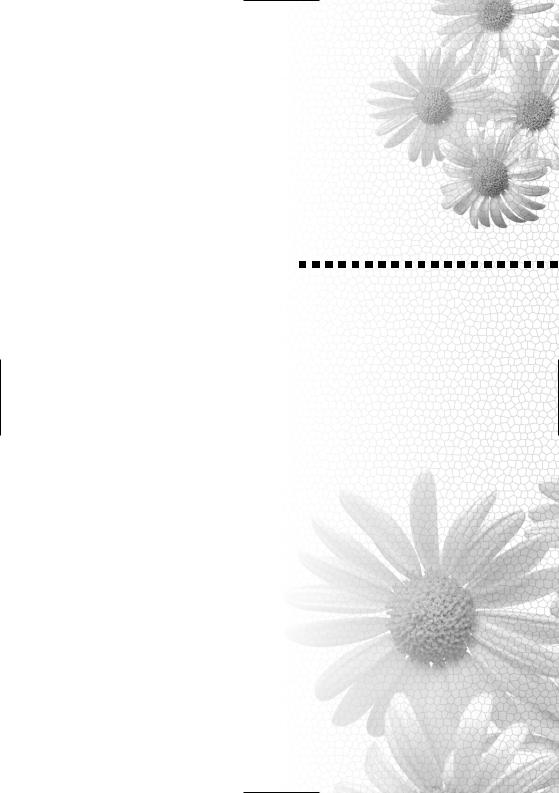
Taking Photographs
Photography (Auto Photography)
Selecting the Scene Mode
Selecting the Focus
Selecting the Flash Mode
Using the Self-timer
Zoom Photography
Photography (Manual Photography)
Selecting the Exposure (EXP)
Selecting the White Balance (WB)
Selecting the Photometry Mode (AE)
Selecting the Capture Mode (S/C)
Exposure Compensation
Taking Movies
Taking Photographs with the Remote Controller Changing the Photography Menu Settings About the Adapter Ring


 Photography (Auto Photography)
Photography (Auto Photography)






Preface |
|
Getting |
Ready |
This is a general-purpose method of photography. Photographs can be taken easily as the camera automatically controls the exposure (combination of shutter speed and aperture) and other settings.
Prepare for taking photographs.
Insert the specified batteries ( page 20) and SD card (
page 20) and SD card ( page 23) into the camera and remove the lens cap.
page 23) into the camera and remove the lens cap.
 Slide the POWER switch to turn the power ON.
Slide the POWER switch to turn the power ON.
|
Photographs |
Turn the mode dial to [ |
]. |
|
Taking |
OWER |
|
||
|
|
|||
PlayingBack |
PhotographedImages |
Compose the photo while viewing the subject through |
||
the LCD monitor or the Electronic View Finder. |
||||
|
|
|||
Deleting |
PhotographedImages |
Connectingto |
thePC |
OtherUseful |
Information |
Additional |
Information |
When using the Electronic View Finder, turn the Diopter adjustment dial until the screen is clear.
Adjust the brightness if the screen is too light or too dark. “LCD BRIGHTNESS”  page 61
page 61
Press the shutter button down halfway q and then full downw.
1 Press down halfway.
2 Press full down.
At the shutter button halfway down position, the camera automatically focuses and calculates the exposure, and at the fully pressed position the camera takes the photograph.
The focus area frame turns green and the viewfinder LED lights green when the camera is in focus. When the exposure is appropriate the AE icon turns green.
If preview is set to “ON”, the preview image (captured image) will be displayed on the LCD monitor for two seconds after you have taken photographs.
“PREVIEW”  page 60
page 60
Important • After you have taken photographs, the viewfinder LED stays lit for the time it takes for the images to be recorded to the SD card. While the viewfinder LED is lit red, never
open the battery cover or card cover, or remove the batteries or SD card. Doing so might damage the SD card or the data in the SD card.
• Open the flash to take pictures with the flash.
• When taking photographs, be careful not to interfere with the lens, flash, or flash
adjustment sensor with the strap or your fingers.
28
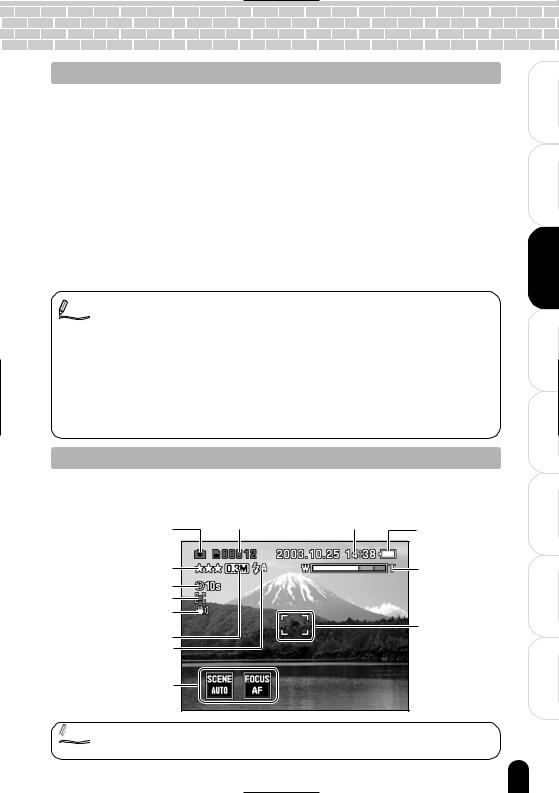
Focusing
•If you want to focus on the subject which is not in the center of the frame, you can point the subject and press the shutter button down halfway first, and then with the shutter button held halfway down (focus and exposure locked), reframe your picture and press the shutter button the rest of the way down to complete the shooting.
•This Digital Still Camera uses an accurate auto-focus mechanism. However, you may experience difficulty focusing or not be able to focus under the following situations:
·When there are objects before or behind the subject
(such as animals inside cages or people in front of trees)
·Very shiny subjects such as a mirror or car body
·Subjects that hardly reflect any light such as hair or fur
·When the contrast is extremely low
(such as people wearing clothes the same color as a background)
·Subjects moving at high speed
·Subjects without substance such as smoke or flame
·Subjects viewed through glass
·When subjects are far away and dark
Memo |
• Light or dark spots, or colored spots sometimes are visible on the LCD monitor. This, |
|
however, is not a malfunction. This spots are not contained in recorded images. |
•The image in the LCD monitor sometimes darkens while the shutter button is pressed down halfway until the image becomes focused.
•Moving the camera while pressing the shutter button will cause the image to be fluctuated.
•When the camera cannot focus on a subject, the focus is fixed at infinity. (When the flash is used, the focal distance is fixed at about 1.5 m. During macro photography, photographs are taken at maximum close range.)
•It sometimes takes several seconds for the flash to recharge. During flash recharging, the viewfinder LED lights (orange). You cannot take photographs while the viewfinder LED is lit (orange).
LCD Monitor/Electronic View Finder Display during Auto Photography
Text, numbers, icons and other information displayed on the screen differ according to the current settings.
Possible number |
Shooting |
of shots |
date and time |
Mode icon |
|
Quality ( page 58) Self-timer icon (
page 58) Self-timer icon ( page 36)
page 36)
AE icon ( page 28)
page 28)
Unsteady hold warning icon ( page 31, 113)
page 31, 113)
Image size ( page 58) Flash icon (
page 58) Flash icon ( page 34)
page 34)
Photography tab menu
Remaining battery power ( page 21)
page 21)
Zoom state ( page 37)
page 37)
Focus area (when the shutter button is pressed halfway)
 Memo • Each press of the DISP button switches between LCD monitor display and Electronic View Finder.
Memo • Each press of the DISP button switches between LCD monitor display and Electronic View Finder.
|
Preface |
Ready |
Getting |
Photographs |
Taking |
PhotographedImages |
PlayingBack |
PhotographedImages |
Deleting |
thePC |
Connecting |
|
to |
Information |
OtherUseful |
Information |
Additional |
29



 Selecting the Scene Mode
Selecting the Scene Mode 






|
Set the scene to photograph such as [ AUTO ] AUTO, [ |
] PORTRAIT, [ |
] LANDSCAPE, |
||||
Preface |
[ |
] SPORTS, [ |
] PORTRAIT + LANDSCAPE, [ |
] NIGHT SCENE or [ |
] MULTI. |
||
The setting still remains after the power is turned OFF manually or by auto power OFF . |
|||||||
|
Turn the mode dial to [ |
]. |
|
|
|
||
|
|
|
|
|
|||
Getting |
Ready |
OWER |
|
|
|
|
|
|
|
|
|
|
|
||
Taking |
Photographs |
PlayingBack |
PhotographedImages |
Deleting |
PhotographedImages |
Connectingto |
thePC |
OtherUseful |
Information |
Press the OK button.
The menu can now be selected.
MENU
OK
DISP
Select [SCENE] with the 
 button, and press the
button, and press the  button.
button.
A list of scene mode icons is displayed.
 Select the icon of the desired scene mode with the
Select the icon of the desired scene mode with the 
 button, and press the OK button.
button, and press the OK button.
Pressing the OK button fixes the setting, and the selected scene mode icon appears at the bottom of the screen. To cancel the selected scene mode, press the  button.
button.
Additional |
Information |
 Press the OK button.
Press the OK button.
The camera is now ready to take photographs.
30
